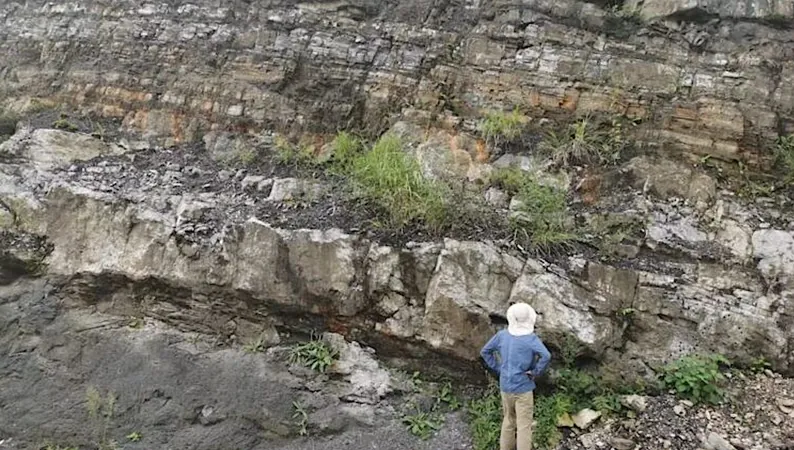
Unveiling Earth's Ice-Covered Past: The Secrets Behind the Last Snowball Earth Event
2024-09-19
Author: Jia
Introduction
Our planet has experienced some of the most profound climatic shifts in its history during "Snowball Earth" events, which took place hundreds of millions of years ago. During these astonishing periods, nearly the entire Earth was draped in ice, with thicknesses reaching up to 0.6 miles (1 kilometer).
These Snowball Earth phenomena have been rare and do not follow a consistent schedule, lasting from millions to tens of millions of years. Following such chilling epochs, Earth underwent dramatic warming, sparking debates among scientists about the specifics of these transitions—until now.
Groundbreaking Research
Recent groundbreaking research from the University of Washington provides new insights into the conclusion of the last Snowball Earth event, proposing it may have catalyzed a significant increase in biodiversity, including the emergence of the first animals on the planet.
Published in *Nature Communications*, the study highlights the significance of ancient rock formations known as "cap carbonates." These unique geological records offer valuable clues about Earth's atmosphere and oceans around 640 million years ago, predating the information obtainable from ice cores or tree rings.
Phases of Transition
The research outlines three crucial phases that marked the end of the Snowball Earth event. Initially, thick ice sheets effectively separated the atmosphere from the oceans. As the climate warmed, freshwater from melting glaciers flowed into the oceans, forming a layer on the water's surface. Eventually, the ocean began to mix again, leading to interactions between the atmosphere, upper layers, and deep waters.
Lead researcher Trent Thomas, a doctoral student in Earth and space sciences, explained, “Cap carbonates hold crucial information about the properties of Earth's atmosphere and oceans, including shifts in carbon dioxide levels and ocean acidity. Our theory clarifies how these factors evolved during and after Snowball Earth.”
Significance of Cap Carbonates
Cap carbonates are composed of layered limestone or dolomite rock and feature a distinct chemical signature. Located in over 50 sites globally—including Death Valley, Namibia, and Australia—these rocks are believed to have formed as glacial ice melted, dramatically transforming atmospheric and oceanic conditions.
The naming of "cap carbonates" comes from their position atop glacial deposits, acting as a testament to the dramatic climatic history beneath. By studying these carbonates, researchers can gain insight into the carbon cycle during periods of extreme climate change. The new models not only illuminate environmental shifts but also shed light on evolutionary milestones on Earth, suggesting a correlation between Snowball Earth events and the emergence of complex life forms.
Evolutionary Changes
David Catling, a senior author of the study and professor of Earth and space sciences at the University of Washington, pointed out that Earth hosted only simple life forms—microscopic organisms, algae, and similar entities—for over 2 billion years preceding Snowball Earth. This era is often dubbed the “boring billion” due to its lack of significant evolutionary changes. Following the Snowball Earth events, however, the fossil record hints at a rapid evolution of more complex life forms.
The recent paper not only discusses the environmental changes during three distinct phases of Snowball Earth but also highlights how atmospheric carbon dioxide accumulation eventually led to a thawing effect that saw a return to global rainfall and a resumption of oceanic circulation.
“Our predictions indicate essential environmental modifications as Earth rebounded from the Snowball epoch, affecting the ocean’s temperature, acidity, and circulation," Thomas asserted. "Understanding these changes brings us closer to determining their impact on life on Earth."
Future Investigations
Future investigations will delve into how certain life forms that may have endured the Snowball Earth period and its aftermath evolved into the more complex organisms that followed.
Conclusion
This intriguing study received support from the National Science Foundation and NASA, including funding from the NASA Astrobiology Program granted to the UW's Virtual Planetary Laboratory. The mysteries of Earth's climatic history continue to unveil themselves, as research into this crucial period could reshape our understanding of life on our planet. What other secrets lurk beneath the ice? Stay tuned as scientists work tirelessly to discover the untold stories of our planet's past!



 Brasil (PT)
Brasil (PT)
 Canada (EN)
Canada (EN)
 Chile (ES)
Chile (ES)
 Česko (CS)
Česko (CS)
 대한민국 (KO)
대한민국 (KO)
 España (ES)
España (ES)
 France (FR)
France (FR)
 Hong Kong (EN)
Hong Kong (EN)
 Italia (IT)
Italia (IT)
 日本 (JA)
日本 (JA)
 Magyarország (HU)
Magyarország (HU)
 Norge (NO)
Norge (NO)
 Polska (PL)
Polska (PL)
 Schweiz (DE)
Schweiz (DE)
 Singapore (EN)
Singapore (EN)
 Sverige (SV)
Sverige (SV)
 Suomi (FI)
Suomi (FI)
 Türkiye (TR)
Türkiye (TR)
 الإمارات العربية المتحدة (AR)
الإمارات العربية المتحدة (AR)